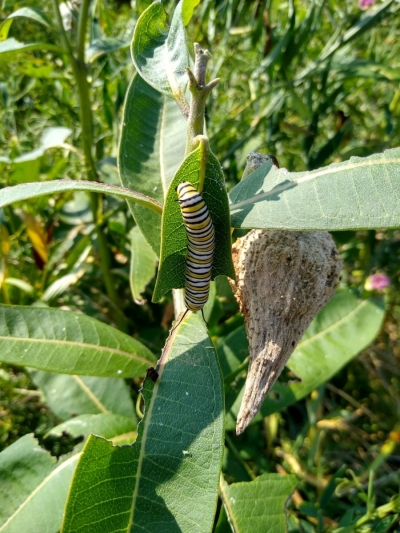
By Jack Monsted, Assistant Curator, Native Plant Trail
Milkweed is the sole host plant for the caterpillars of the beautiful, threatened monarch butterfly and efforts to preserve this butterfly have brought this once overlooked plant into the public consciousness. Images of its fascinating, orb-like inflorescence can regularly be found gracing the front pages of news websites and anyone even remotely interested in gardening has no doubt heard exhortations to plant milkweed “for the butterflies.”
But what exactly is milkweed? And why do monarch caterpillars love it so much? Since many of the arboretum’s milkweeds are blooming around now, this is an excellent time to shed some light on these extraordinary and often enigmatic plants.
A Multiplicity of Milkweeds
The first thing to know about milkweed is that it is not simply one species of plant, but an entire genus. The milkweed genus (known as Asclepias in botanical nomenclature), contains around 100 unique species, all native to different parts of North and Central America. Of these 100 species of Asclepias, 13 are found naturally occurring in Virginia.
Our native milkweeds all have several things in common. First, they all contain the milky white sap for which they are named. The white color comes from latex, a sticky substance that deters browsing by many insect and mammal species. In addition to this latex, their leaves also contain toxic compounds called cardiac glycosides meant to further discourage hungry animals. Second, they all share a similar flower shape – geometric, roughly cylindrical blooms which always feature five unique ‘hoods’ around the outside which store the sugary nectar their pollinators are searching for. They’re also all perennial herbs which grow from rhizomes, meaning the stems die back each winter but regrow from the same root material every spring. And finally, they’re all essential habitat for a diverse range of insects, from the humble milkweed beetle to the gorgeous monarch.
Other attributes of the plants, such as the color and size of their flowers, the shape of their leaves, their preferred habitats, and the periods during which they bloom, vary wildly from species to species. For example, common milkweed (Asclepias syriaca) can grow up to five feet tall, has very wide leaves and large clusters of purple flowers up to four inches in diameter. By contrast, butterflyweed (A. tuberosa) only gets up to two or three feet tall, has bright orange flowers, and very narrow leaves. Both species typically bloom in June. Swamp milkweed (A. incarnata) has clusters of tiny but bright pink flowers, typically blooms in August, and grows in wetlands and occasionally flooded areas instead of the dry, sunny meadows the other two prefer.
The list goes on – tall milkweed (A. exaltata) prefers a bit of shade and gets up to 6 feet tall, while green milkweed (A. viridiflora) has unique pale green flowers. All these factors mean that if you ever do decide to plant milkweed it’s important to consider which of our native milkweed species will work best where you want to plant them.
Milkweed Munchers
Milkweeds are host to a dizzyingly diverse array of insects that are often highly specialized and can only be found on milkweed plants. The reason for this is the toxic chemicals in the leaves and sap mentioned earlier. While many pollinators will consume nectar from its flowers, only organisms that have evolved defenses to milkweed’s poisons can consume the plant directly.
An interesting side-effect of this co-evolution is that many of milkweed’s herbivores absorb and sequester the plant’s toxins in their own bodies, becoming toxic themselves. They advertise this toxicity often through bright red or orange markings, which warn potential predators that snacking on them would be a mistake. Such markings are present on the bright red milkweed beetles which eat the leaf buds and flowers of milkweed. The same is true of monarchs which eat lots of milkweed leaves as caterpillars but retain the orange coloration (and the protective toxins) as adults. Even the diminutive milkweed bugs that feast on the plant’s seeds are bright orange in color.
Other less showy insects which rely exclusively on milkweed include milkweed tussock moths, swamp milkweed beetles, and even specialized milkweed aphids which are prime food for ladybugs.
Despite their amazing botanical diversity and the myriad lives they support, there’s something simply enchanting about coming across a cluster of milkweed, whether in your own garden or in a natural area. Their flowers are truly unique from every other plant on Earth, instantly recognizable from even the briefest of glances. And given that their native range is strictly limited to north and central America, they’re a key part of our natural history, perhaps even our identity as residents of this land. For me, hiking through a milkweed patch feels less like a journey into the wild and more like coming home.
